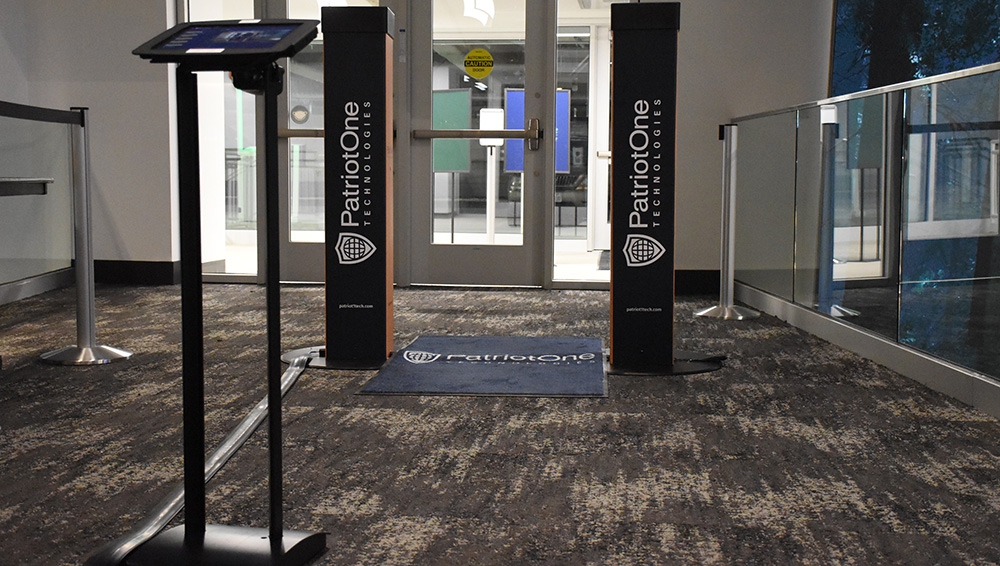OIG selects Patriot One’s patron screening solution for D.C. headquarters building Multi-Sensor Gateway detection system to increase speed of access entry, while improving employee safety

By Cory Harris, Editor
Updated 8:22 AM CST, Wed February 16, 2022

TORONTO—A new patron screening solution that is designed to make access entry quicker and more efficient is coming to The U.S. Office of the Inspector General (OIG) headquarters building in Washington, D.C.
Patriot One Technologies, a manufacturer of unobtrusive, AI-driven weapons and threat detection systems, recently announced that OIG selected the innovative security company’s Multi-Sensor Gateway autonomous detection system to secure employee entrances at the headquarters.
This next-generation patron screening solution will play an important role in improving employee safety at the OIG headquarters building, while providing security personnel with a more convenient experience by eliminating the need for people to empty their pockets or have their bags checked separately. The Multi-Sensor Gateway solution is able to detect weapons and other threats before they have a chance to cause harm.
As a result of this partnership, the D.C. Protective Services Division - which provides 24-hour security and special police services that support District government operations, as well as protection of employees, resources, and facilities at approximately 840 District-owned and leased properties, including OIG headquarters - will be able to provide a safer environment for all who work or live in the district.
The project was conducted with Maven Security Technologies, a D.C.-based security company that provides solutions for biodefense, access control and intelligent threat detection. The combination of Maven Security’s consulting services with Patriot One’s Multi-Sensor Gateway technology allowed OIG to elevate its screening process with higher accuracy than traditional walkthrough metal detectors.
Innovative Partnership
 Peter Evans, CEO of Patriot One, told Security Systems News that the partnership between Patriot One and OIG started developing in 2021 when OIG expressed interest in the company’s patron screening solution.
Peter Evans, CEO of Patriot One, told Security Systems News that the partnership between Patriot One and OIG started developing in 2021 when OIG expressed interest in the company’s patron screening solution.
“About five or six months ago, we had some inbound interest from OIG itself and the D.C. Department of General Services [DGS],” he said. “During that same timeframe, we were being selective about the partners we wanted to engage with in the marketplace to grow and expand our channel.
“We met the folks at Maven, and what we liked a lot about Maven was that they’re very specialized and focused on the Washington, D.C. area, and they have some very long and deep respective relationships. As it turned out, Maven was in a meeting with the folks at OIG as they had been going through some analysis of all sorts of different technologies, and they were disappointed in some of those activities and the results they’d seen post technologies. They asked Maven, ‘Can you do some research for us?’ and they did their own independent research. OIG called us, Maven did their own research and called us, and all of a sudden everything came together very, very nicely.
Evans continued. “Over the course of about six months of work with them – analysis, understanding their environment, how our product fit – we started to build out a very programmatic view on how we were going to work with them and deploy things.”
He added that what he likes about Patriot One working with OIG and the Department of General Services is that it is not just a pure vendor-customer relationship.
“There are a lot of very interesting things that they’re thinking about, in terms of how to make environments much more safer, and how do I leverage digital technology to provide the same sort of business benefits that we’ve seen for so many other industries,” he explained. “Look what’s happened to retail, which has gone from brick-and-mortar stores in a labor-based business model to Amazon. Can I leverage digital technology the same way to enhance the security posture for places like Washington, D.C. and across the country?
“We like it because that speaks to kind of an innovative partner on a macro scale that we can work with, as well as make our federal locations that much more secure.”
Multi-Sensor Gateway
Evans noted how the Multi-Sensor Gateway, which sits on an AI-powered platform, can detect threats on individuals carrying concealed guns, knives or other threat objects into secured private or public spaces such as OIG headquarters.
“At its simplest level, we’re all familiar with things like a walkthrough metal detector,” he said. “That technology was built 40 years ago. Walkthrough metal detectors became prevalent during that time, and they haven’t changed in 40 years. That’s the problem we have with society’s demands for security have changed radically, and people are still using old, labor-based models with old technology.
“We are a weapons detector, and the marked difference is that we can detect that this is a smartphone, this is a cellphone, this is a watch, this is a wallet, and not alert on that, so you don’t have to divest of those things when you walk in the building. You just walk in, like you’re walking in the front door of a building like a Target store or a hotel. It’s only if you have a weapon – a knife, a gun, those sorts of things – that it would actually alert and you pull people aside. That’s what it does at its basic level.”
Evans expanded on what the Multi-Sensor Gateway technology does on a more advanced level.
“For completeness, we augment that technology where we take that same digital innovation and put it on video cameras,” he explained. “That’s where we can actually do things like detect weapons at a distance of 100 or 125 feet or so, upon approach to a building. Now you can think of things like a school or the U.S. Department of Health and Human Services that DGS provides services to. Maybe they’re angry they’re not going to get their welfare check, so they’re pulling out a gun. I can see someone walking across the parking lot toward the building, and I’ve got early warning. I can be preemptive.
“I can tie the software to lockdown systems that will lock the doors and alert the police. The same software can look for fights, crowd disturbances, anomalies. Why are four people hanging by the back door when no one’s done that before? Why has the same car driven in front of the building five times in the last minute? That’s unusual.”
Evans added, “At its basic level, we discern the difference on the entry to the building with the Multi-Sensor Gateway between weapons and benign objects, and we alert on those. Those alerts can be a simple alert on the pillars themselves, or on smartphones for roaming law enforcement officers that could take a picture of a person and it will superimpose upon it a red circle exactly where the weapon is on your body - right front pocket, left ankle, those kinds of things. I’m now giving the officer much more detail. It changes the dynamic of the conversation when I walk up to you and say, ‘Sir, you have weapon in your right front pocket.’ It can disarm a situation very quickly.”
With the security benefits that Patriot One’s Multi-Sensor Gateway solution provides, Evans noted that after having conversations with OIG, the agency came away with the feeling that this technology “could really change the dynamic and provide security services in a manner that is nonobtrusive and respects personal privacy but keeps weapons threats to a minimum.”
Evans offered some simple math when weighing the advantages of Patriot One’s weapons detector versus the classic walkthrough metal detector.
“Walkthrough metal detector – slow. About 500 people an hour is the average,” he stated. “When you think about people walking into a stadium, like Capital One Arena in Washington, D.C., let’s say they’ve got about 18,000 patrons coming to see the [National Hockey League’s Washington] Capitals play, it’s January, there’s an ice storm, and people have to stand outside in a line while they wait for these walkthrough metal detectors.
“Second, you have to divest of all of your personal stuff, you put it in a bin, you walk through, you beep. You go back, you go forth, you go back, you go forth. Everyone behind you is getting frustrated, so you’re getting agitated crowds, which is not something we want to provoke during this time of social unrest. With our technology, you just walk right in.”
He continued. “On average, depending on the venue, depending on the demographics, with 2,000 to about 3,600 people an hour through a lane, let’s call it four to seven times faster. Because of that, you also don’t need as much security staff, so I can redeploy that staff. Maybe I want people patrolling the parking lots. Maybe I want them on the concourse area. It allows stadiums to be much more judicious about how they deploy their staff.
“In addition, we collect all the data and we provide almost a dashboard of everything that is going on – how long is every single line at every door? How long does it take to get people through ticketing? How long does it take to go through security? Where do I have hotspots in terms of backups? Now I have data analytics that allow me to fine-tune my operations not only for security best practices, but also for operations best practices and for the patrons’ experience best practices. The more security we needed, the more the patrons’ experience went down. Now I can actually do this and make it a better experience, while lowering my operational costs and getting patrons in seven times faster.”
Working with Maven
Evans cited Maven’s “very pragmatic approach” to how to deploy things as a catalyst in spearheading the Patriot One-OIG partnership.
“Maven really looks at things from the approach of people, process, and technology,” he explained. “Technology by itself is going to fail, unless you’ve got the right processes around utilizing it, and the right training around the staff. We really like that about their approach, and how they look at things very holistically to ensure the customer gets the outcomes that they’re looking for.
“They’re very respected in the Washington, D.C. area with a lot of federal organizations. While we provide great technology and great solutions, it’s always great to have an expert practitioner layer on top of that sort of expertise.”
Evans added that Patriot One is working with Maven on a number of other projects to be announced at a future date.
“We really like the partnership there,” he said of Maven. “They share the same sort of philosophy of us, which is this understanding that technology isn’t perfect, and it will change over time. We like working with Maven because they recognize this is not just a one-and-done; we’re building a long-term relationship with people like OIG. We like them a lot.”
Benjamin Wells, CEO and founder of Maven Security Technologies, added, “We are constantly looking for new, cutting-edge security technology that we can utilize to improve our client’s overall security posture, and that improves their operations, reduces costs, and brands them as innovators. We reviewed a number of alternative solutions. Patriot One’s advanced technology was a perfect fit for OIG and what they are looking to accomplish at their headquarters location, with the plans and the potential to expand this type of deployment at other D.C. agencies in the future.”
Timeline
The first deployments of Multi-Sensor Gateway solutions for access entry at the OIG headquarters building are currently taking place, Evans said, adding that there are other buildings in the D.C. area being discussed where Patriot One’s security solutions might be added.
“The plan is for multi-phase deployments,” he noted of the OIG headquarters plan. “We’re starting with the headquarters building, and we’re starting to talk about the next sets of buildings – camera systems around various service centers for Health and Human Services and things like that.”
Evans pointed out that in addition to government buildings, Patriot One’s Multi-Sensor Gateway solutions are currently deployed at sports stadiums, schools, casinos, manufacturing organizations, distribution organizations, e-commerce organizations, and commercial properties.
In addition to the Multi-Sensor Gateway solution, Patriot One manufactures an AI-based Video Recognition System that enables venue and building operators to identify weapons and other threats inside and outside of facilities, while also providing valuable intelligence for optimizing operations via its AI-powered platform.
Evans noted that Patriot One’s partnership with OIG – the executive branch agency of the federal government that conducts audits, inspections, and investigations of government programs and operations - is a win-win for all entities involved.
“It’s always fantastic to have a partner like OIG,” he said. “We see them not only as a customer, but also much more as an innovative partner. OIG understands the importance of protecting its employees and the broader community and is a big believer in being ahead of the security technology curve. Using the most modern, innovative security technology allows them to protect employee entrances and deliver a more efficient, professional experience.”
For more on Patriot One’s AI-powered solutions, please visit: https://patriot1tech.com/patscan/products/.
Comments